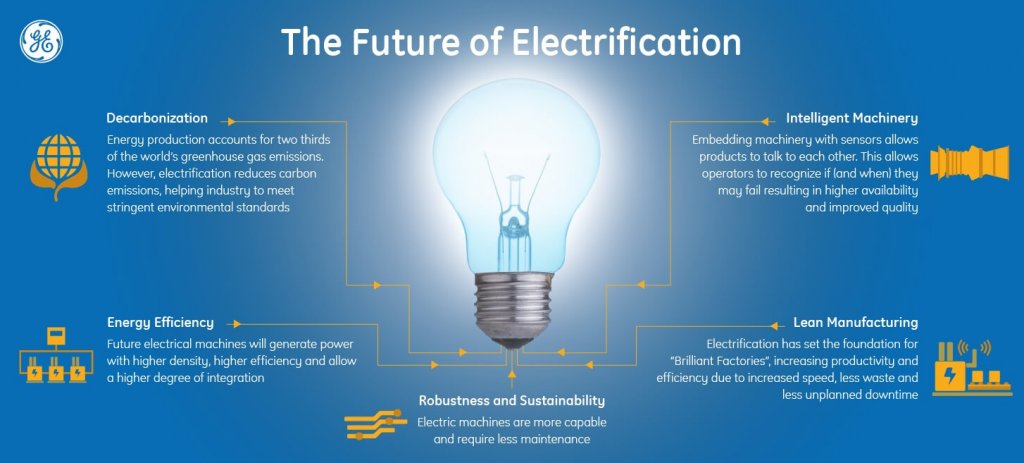Richard Zhang, Technology Executive, GE’s Power Conversion
We are living in a dynamic global power environment. We all need the same thing—affordable, sustainable, reliable power, and the demand is growing. While the power sector is leading the way towards a decarbonized energy system, electricity gains ground in many sectors and will make up about 25 percent of final energy consumption by 2040, as estimated by IEA.
 With the benefits of electrification recognized (not just in helping reduce carbon emissions, but also offering significant cost and efficiency savings), increasingly innovative electric consumer devices, which impact our everyday lives, are being developed at a rapid rate. While many would say the consumer-facing world has been quick to embrace this electrification, the industrial world has too—it just might not be quite so obvious to all.
With the benefits of electrification recognized (not just in helping reduce carbon emissions, but also offering significant cost and efficiency savings), increasingly innovative electric consumer devices, which impact our everyday lives, are being developed at a rapid rate. While many would say the consumer-facing world has been quick to embrace this electrification, the industrial world has too—it just might not be quite so obvious to all.
Electrification benefits realized over 100 years ago
GE has a steep history in electrification, going back over 100 years. Charles Steinmetz, founder of GE’s research center, claimed in 1917, “I believe the Electric will be the car of the future on account of its simplicity of operation and reliability.” Today, we are not short of examples where electrical machines play a prominent role in industrial operations. The difference is that, for many, these electrical operations are hidden and embedded inside equipment—making them the “hero behind the scenes.”
Looking to the marine industry as an example, GE’s Marine Solutions’ power take off and power take in (PTO/PTI) technology harnesses the mechanical energy of the vessel’s propulsion shaft to convert it into electrical energy. The shaft generator motor, installed between the engine and the propeller, can either contribute to propulsion power with onboard power generation or “absorb” power from the rotation of the propeller shaft and redirect it to onboard systems, therefore diminishing the need to burn fuel to power onboard systems and resulting in significant fuel savings.
GE has also developed electric drive compression systems for LNG projects in North America. The solution provides an alternative process to traditional mechanically driven devices, powered by gas itself or other fossil fuels. Electrified LNG infrastructure holds the key to transforming LNG production by making it cleaner and more efficient. It helps LNG production plants to meet the stringent environmental and carbon emission standards expected.
Furthermore, the vast benefits that electrification has brought to the world of aviation shouldn’t be forgotten. This ranges from safety—hybrid electric propulsion can help extend flying time in emergencies, while electric drivetrains are also less mechanically complicated, leaving less room for error—all the way through to significant efficiency and fuel savings. And that’s not to mention the role electrification plays in reducing noise and cutting down carbon emissions.
Making energy production cleaner, more robust and sustainable
As energy production accounts for two-thirds of the world’s greenhouse gas emissions, reduction of carbon emissions in the energy sector is of paramount importance. The United Nations COP21 meeting drew the world’s attention to the importance of the global climate change challenge and the option of a decarbonized future. Renewables is an obvious way to reach the target; electrification is another important way to produce clean and reliable energy.
As we have discussed previously, through electrification, we can make energy production cleaner, more robust and sustainable. Electric machines are more efficient, more capable and require less maintenance. Drawing from this solid foundation, future electrical machines will generate power with higher density, higher efficiency and allow for a higher degree of integration.
Using new materials inside this electric equipment is another innovative way to increase efficiencies—for example, the use of Silicon Carbide (SiC)-based power semiconductor devices in inverter technology. SiC, a synthetically produced crystalline compound of silicon and carbon, was first discovered in an attempt to produce artificial diamonds and shares many of its properties, including strength and resistance to high temperatures. These features, combined with electrical conductivity with 10 times faster switching and heat losses reduced by half, make the material the ideal substitute for traditional semiconductors, giving it the potential to completely transform the power conversion methods used today.
Intelligent machines increasing productivity and efficiency
Adding intelligence to machines also increases productivity and efficiency. In GE’s Brilliant Factories, it is optimizing performance by embedding sensors throughout all machines and operations. By putting this “digital thread” through all operations, the machines can talk to one another, enabling them to work efficiently and intelligently with increased speed, less waste and decreased unplanned downtime. This is because, by connecting and listening to machines, GE is able to recognize if (and when) they may fail and move to fix them faster—resulting in higher availability, lower costs and improved quality.
From the shop floor to equipment performance, electrification is in expansion. While the benefits of electrification are already being felt, the development in the industrial world must be accelerated. Understanding this, GE’s aim is to put “electric” back into General Electric to ensure it is at the forefront of the electric wave.
Filed Under: Uncategorized




